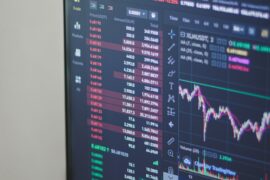This article may contain references to products or services from one or more of our advertisers or partners. We may receive compensation when you click on links to those products or services. Nonetheless, our opinions are our own.
The information presented in this article is accurate to the best of our knowledge at the time of publication. However, information is subject to change, and no guarantees are made about the continued accuracy or completeness of this content after its publication date.
If you want an investment that has a good chance of making a lot of money and a good track record, you might want to look into Growth at a Reasonable Price (GARP) ETFs. These funds not only want to grow over time, but they also stress the importance of fair prices. This makes them a good choice for investors like you who want to be smart about how they invest. We’ll go into more detail about why GARP ETFs have become popular with both new and experienced investors. We’ll look at their performance history and the reasons they make a good addition to your investment portfolio. GARP can help you make smart choices in today’s market, whether you’re a seasoned pro or just starting out.
- GARP and Its Appeal for Growth Investors
- The Sweet Spot Between Growth and Value
- How GARP ETFs Select Their Holdings: The “Rules-Based” Approach
- Specific GARP ETFs
- iShares MSCI USA Quality GARP ETF (GARP)
- Invesco S&P 500 GARP ETF (SPGP)
- Global X S&P World ex Australia GARP ETF (ASX:GARP)
- How GARP Strikes the Right Balance Between Growth and Value
- Analyzing GARP’s Historical Performance and What It Means for You
- Where GARP Funds Shine
- Tips for Incorporating GARP into Your Investment Strategy
- Potential Risks to Consider When Investing in GARP ETFs
- Conclusion
- Frequently Asked Questions
- Recommended Reads
GARP and Its Appeal for Growth Investors
You might like that it takes a balanced view, looking for companies with strong growth potential while also keeping an eye on your budget. This strategy tells you to look at stocks that not only promise to make money in the future, but also have reasonable prices right now. This will make you feel good about your investments.
Risk Mitigation: By targeting growth companies that are also reasonably priced, you may reduce the risk of overpaying for exuberance, which is common in pure growth investing.
Consistency: GARP seeks out firms with a history of steady earnings growth, which can provide a more stable investment trajectory.
Informed Decision-Making: This approach encourages a detailed analysis of valuation metrics, helping you make more educated investment choices.
To help you better understand the GARP framework, here’s a simple comparison of GARP with traditional growth and value investing:
| Investment Style | Focus | Risk Level | Typical Investor |
|---|---|---|---|
| Growth Investing | High-growth potential | High | Bold investors seeking rapid returns |
| Value Investing | Undervalued assets | Moderate | Conservative investors prioritizing safety |
| GARP Investing | Growth with reasonable pricing | Balanced | Informed investors seeking a blend of growth and safety |
In the end, GARP can help your investment strategy by combining the search for growth with smart valuation. This makes it a powerful tool in your financial toolbox.
The Sweet Spot Between Growth and Value
Differences Between GARP and Pure Growth Investing:
The fundamental distinction lies in valuation discipline.
Pure Growth Investing:
- Focus: Companies with high, often accelerating, revenue and earnings growth rates.
- Valuation: Often willing to pay a premium (high P/E ratios, etc.) for anticipated future growth. The belief is that rapid growth will eventually justify the current high valuation.
- Risk: Higher risk due to potential for significant price drops if growth slows or misses expectations, or if market sentiment shifts away from high-multiple stocks. Often concentrated in specific sectors like technology.
- Example Companies: Early-stage tech companies, biotech firms with breakthrough potential, or companies rapidly disrupting traditional industries.
GARP (Growth at a Reasonable Price) Investing:
- Focus: Companies with consistent and sustainable earnings growth, but at a “reasonable” or fair valuation.
- Valuation: Emphasizes metrics like the PEG ratio (Price/Earnings to Growth). A PEG ratio of 1 or less is generally considered desirable, meaning the P/E ratio is roughly equal to or less than the expected earnings growth rate. This helps avoid overpaying.
- Risk: Aims to mitigate the risks of pure growth by incorporating a value component. It’s often seen as a more defensive growth strategy. Less susceptible to drastic corrections during market downturns compared to pure growth.
- Example Companies: Established tech giants with consistent growth and strong free cash flow (e.g., Microsoft, Apple, Visa), stable consumer brands, or certain industrial companies with a competitive edge.
GARP emphasizes “compounders”: companies that generate high returns on invested capital (ROIC) and can consistently reinvest their profits to fuel future growth. This suggests a focus on quality, strong management teams, and healthy financials.
How GARP ETFs Select Their Holdings: The “Rules-Based” Approach
GARP ETFs are typically index-based and employ a rules-based, systematic methodology to select holdings. This means they follow predefined criteria rather than relying on active management’s subjective decisions. While the exact rules vary by index provider, common factors include:
Growth Metrics:
- Earnings Per Share (EPS) Growth: Historical and/or projected EPS growth rates (e.g., 3-year EPS growth).
- Sales Growth: Similar to EPS, looking for consistent revenue expansion.
- Return on Equity (ROE) or Return on Invested Capital (ROIC): Measures how efficiently a company generates profits from its equity or capital, indicating quality and profitability.
Value Metrics:
- Price-to-Earnings (P/E) Ratio: Comparing the stock price to its earnings.
- Price/Earnings to Growth (PEG) Ratio: The cornerstone of GARP. Calculated as P/E ratio divided by the annual EPS growth rate. A lower PEG (ideally ≤1) is preferred.
- Price-to-Book (P/B) Ratio: Compares a company’s market value to its book value.
- Price-to-Sales (P/S) Ratio: Compares a company’s market value to its revenue.
Quality Metrics:
- Financial Strength: Often assessed by debt levels (e.g., low financial leverage ratio).
- Profitability Margins: Gross, operating, and net profit margins to indicate efficiency.
- Free Cash Flow (FCF) Yield: Indicates a company’s ability to generate cash.
- Economic Moat: While harder to quantify for an index, some methodologies implicitly favor companies with sustainable competitive advantages.
The Selection Process:
- Universe Definition: Start with a broad universe (e.g., S&P 500, MSCI USA, World ex Australia).
- Scoring/Ranking: Companies are scored or ranked based on a combination of these growth, value, and quality factors.
- Constituent Selection: A predefined number of top-scoring companies are selected for the index (e.g., approximately 75 for SPGP, around 130-250 for others).
- Weighting: Holdings might be market-cap weighted (common for many ETFs), or sometimes an equal-weighting or modified weighting scheme is used to prevent overconcentration in a few mega-cap stocks.
- Rebalancing: The index is periodically rebalanced (e.g., semi-annually) to ensure the portfolio continues to meet the GARP criteria, adding new eligible companies and removing those that no longer qualify.
Specific GARP ETFs
Let’s look at the methodologies, holdings, and sector breakdowns of the ETFs previously mentioned, based on the latest available data.
- Methodology: Tracks the MSCI USA Quality GARP Select Index. This index identifies U.S. large and mid-capitalization growth stocks that also exhibit favorable value and quality characteristics. The “Quality” aspect implies strong financial health, profitability, and stability.
- Metrics Used (Implicitly or Explicitly via Index): Likely incorporates measures of earnings growth, P/E ratio, and quality factors like return on equity, debt levels, and earnings variability.
- Holdings (as of May 29, 2025): 132 equity holdings.
- Top 5 Holdings:
- Microsoft Corp (MSFT): 5.84%
- NVIDIA Corp (NVDA): 5.21%
- Mastercard Inc Class A (MA): 5.12%
- Tesla Inc (TSLA): 4.32%
- Apple Inc (AAPL): 4.27% (Note: The top 10 holdings account for ~44% of assets, indicating some concentration in large-cap tech/payment processing firms, but still reasonably diversified.)
- Top 5 Holdings:
- Sector Breakdown (as of May 29, 2025):
- Information Technology: 49.69%
- Consumer Cyclical (Discretionary): 13.19%
- Financial Services: 11.82%
- Communication Services: 10.76%
- Industrials: 6.10%
- Healthcare: 4.39%
- Energy: 2.73%
- Real Estate: 0.85%
- Basic Materials: 0.37%
- Utilities: 0.09%
- Analysis: A significant tilt towards Technology, which is common for growth-oriented funds, but the inclusion of Financials and Industrials suggests the “Quality GARP” filter is effective in broadening beyond pure tech.
Invesco S&P 500 GARP ETF (SPGP)
- Methodology: Tracks the S&P 500® GARP Index. This index focuses on approximately 75 S&P 500 companies with robust growth characteristics combined with higher quality and lower valuations.
- Growth: 3-year earnings per share growth, 3-year sales per share growth.
- Value/Quality: Price-to-earnings ratio, return on equity, financial leverage ratio.
- Holdings (as of June 2, 2025): 73 equity holdings.
- Top 5 Holdings:
- NVIDIA Corp (NVDA): 2.63%
- Marathon Petroleum Corp (MPC): 2.49%
- Valero Energy Corp (VLO): 2.39%
- Ulta Beauty Inc (ULTA): 2.24%
- EOG Resources Inc (EOG): 2.19%
- Top 5 Holdings:
- Sector Breakdown (as of June 2, 2025):
- Energy: 22.70%
- Consumer Cyclical (Discretionary): 16.07%
- Financial Services: 16.61%
- Technology: 15.91%
- Industrials: 11.43%
- Basic Materials: 8.12%
- Consumer Defensive (Staples): 2.93%
- Communication Services: 2.22%
- Healthcare: 2.11%
- Real Estate: 1.90%
- Analysis: This ETF has a notably different sector allocation compared to the iShares GARP ETF. Its significant weighting in Energy and Basic Materials suggests a different interpretation of “reasonable price” and quality, potentially capturing cyclical growth within value sectors. This highlights how different index methodologies can lead to distinct portfolios even under the same “GARP” umbrella.
Voted "Best Overall Budgeting App" by Forbes and WSJ
Monarch Money helps you budget, track spending, set goals, and plan your financial future—all in one app.
Get 50% OFF your first year with code MONARCHVIP
Global X S&P World ex Australia GARP ETF (ASX:GARP)
- Methodology: Tracks the S&P World Ex-Australia GARP Index. This index aims to identify global companies (excluding Australia) that demonstrate strong earnings growth, solid financial strength, and reasonable valuations. It specifically looks for an appealing PEG ratio. Aims for around 250 holdings.
- Metrics Used: Earnings growth, P/E ratio, and quality filters.
- Holdings (as of May 22, 2025): 248 equity holdings.
- Top 5 Holdings:
- Berkshire Hathaway Inc Class B (BRK.B): 5.45%
- Microsoft Corp (MSFT): 5.06%
- Meta Platforms Inc Class A (META): 5.02%
- NVIDIA Corp (NVDA): 4.76%
- Alphabet Inc Class C (GOOG): 4.29% (Note: The top 10 holdings account for ~38% of assets. This ETF includes global giants, with a mix of established tech, financials, and energy.)
- Top 5 Holdings:
- Sector Breakdown (as of May 22, 2025):
- Financial Services: 22.13%
- Technology: 21.21%
- Energy: 16.39%
- Communication Services: 12.35%
- Consumer Cyclical (Discretionary): 9.73%
- Industrials: 9.75%
- Healthcare: 2.84%
- Consumer Defensive (Staples): 2.50%
- Basic Materials: 1.68%
- Utilities: 0.91%
- Real Estate: 0.50%
- Analysis: This global GARP ETF shows a much more balanced sector allocation, with Financials, Technology, and Energy all having significant weight. This broader diversification reflects its global mandate and a possibly less tech-centric interpretation of growth.
Additional Insights:
- Smart Beta ETFs: All these GARP ETFs fall under the “smart beta” category. Unlike traditional market-cap-weighted ETFs that simply hold companies based on their size, smart beta funds track non-cap-weighted strategies that aim to achieve specific investment objectives (like GARP) by systematically selecting and weighting securities based on factors beyond market capitalization.
- Volatility: While aiming for lower risk than pure growth, GARP ETFs can still experience volatility. Their rules-based approach means they are not immune to market swings.
- Turnover: Index rebalancing can lead to portfolio turnover, which might have tax implications depending on your jurisdiction and account type.
- Diversification: While focusing on GARP, these ETFs offer diversification across multiple companies, reducing single-stock risk.
- Underlying Indexes: Always research the specific index an ETF tracks. The index methodology is the heart of a passive ETF’s strategy.
How GARP Strikes the Right Balance Between Growth and Value
It can be hard to find the right balance between growth and value when you invest, but GARP makes it easy. You can get the best of both worlds by focusing on companies that are expected to grow quickly and are also reasonably priced. This plan lets you take advantage of the chance for capital growth while also getting some protection, which is something that established companies with strong fundamentals often offer.
Focus on Earnings Growth: Look for stocks with enduring and strong projected earnings growth, which frequently leads to increased stock prices over time.
Valuation Metrics: GARP investors typically use metrics like the Price-to-Earnings (P/E) ratio to ensure they are not overpaying for growth.
Quality Companies: Favor businesses with solid revenue streams, robust balance sheets, and competitive advantages within their industries.
To illustrate the effectiveness of this approach, consider the following table that summarizes some notable companies that embody a GARP strategy:
| Company | Projected Growth Rate | P/E Ratio |
|---|---|---|
| Company A | 15% | 20 |
| Company B | 12% | 18 |
| Company C | 18% | 25 |
This mix of growth potential and reasonable prices makes a strong path to reaching your financial goals without taking on too much risk. Following these rules will help you take advantage of both quick growth opportunities and the safety net that value stocks often offer.
Analyzing GARP’s Historical Performance and What It Means for You
When looking at GARP (Growth at a Reasonable Price) ETFs, looking at how they have done in the past can help you understand how strong they are and how much money they could make. These ETFs have shown a strong growth path over the past ten years, often outpacing the broader market indices. For example, GARP ETFs have done very well during times of economic growth because they can balance growth with value. This alignment can help you reach your investment goals without putting you at too much risk.
Consider the following points when evaluating GARP’s historical performance:
Consistent Returns: GARP ETFs have frequently delivered double-digit annualized returns, making them an attractive option for long-term investors.
Lower Volatility: Compared to pure growth stocks, GARP ETFs generally exhibit less price volatility, which can be beneficial in turbulent market conditions.
Resilience in Down Markets: Historically, GARP strategies have shown the ability to weather economic downturns better than many high-growth counterparts.
Where GARP Funds Shine
When looking at sector allocations, it’s important to think about how GARP funds move through different market environments. These funds usually put money into sectors that have both growth potential and value. This lets you take advantage of industries that are often undervalued but ready to grow. Here are a few areas where GARP funds truly excel:
Technology: With consistent innovation, the tech sector remains a stronghold for GARP investments. Companies in cloud computing, AI, and cybersecurity can offer growth, and their current valuations often reflect this dual appeal of innovation and soundness.
Healthcare: As the population ages and medical advancements continue, the healthcare sector provides an intriguing opportunity. GARP funds can capitalize on established companies with innovative products that are consistently growing while still being available at reasonable valuations.
Consumer Discretionary: With an evolving consumer landscape, GARP strategies often target retailers and service companies that manage to balance growth with value, ensuring you invest in businesses that cater to changing consumer preferences.
Here’s a sample breakdown of typical sector weightings in GARP funds:
| Sector | Typical Weighting (%) |
|---|---|
| Technology | 30 |
| Healthcare | 25 |
| Consumer Discretionary | 20 |
| Industrials | 15 |
| Financials | 10 |
This snapshot shows how GARP funds usually spread out their investments. It shows that they focus on both growth sectors and sectors with good valuations. You can get a better idea of where GARP strategies are likely to do well over time by looking at these allocations. It’s a step that gives you the power to make smart investment choices that help you reach your financial goals.
Tips for Incorporating GARP into Your Investment Strategy
Incorporating GARP into your investment strategy involves finding a balance between growth potential and reasonable valuations. Here are some practical tips to get you started:
Research Potential Stocks: Focus on companies demonstrating consistent earnings growth while trading at moderate price-to-earnings ratios. These stocks generally offer a better risk-return profile.
Diversify Your Portfolio: Spread your investments across different sectors and industries. This helps mitigate risks while still participating in growth opportunities.
Assess Debt Levels: Look for companies with manageable debt. High leverage can be a red flag, even for otherwise promising stocks.
Monitor Economic Indicators: Stay informed about macroeconomic trends and market conditions that can impact growth rates and company earnings.
You can also evaluate investments using a GARP criteria table:
| Company | Growth Rate (%) | P/E Ratio | Debt/Equity Ratio |
|---|---|---|---|
| Company A | 15 | 20 | 0.5 |
| Company B | 10 | 15 | 0.3 |
By regularly evaluating your investments against these criteria, you’ll be better equipped to identify GARP opportunities that align with your financial goals.
Potential Risks to Consider When Investing in GARP ETFs
When you think about investing in GARP ETFs, it’s important to keep in mind the risks that could affect your returns. Market volatility is one of the main worries. Even if you use a balanced approach that includes both growth and value, GARP ETFs can still see big changes in price. When the market is unstable, you might see big drops in the short term, which can be scary. So, it’s important to be ready for these ups and downs and know that you may need to think about the long term.
Sector concentration is another thing to think about. A lot of GARP ETFs may have a lot of money in certain sectors, like technology or healthcare. These sectors may grow steadily, but they may also be more vulnerable to changes in regulations or economic downturns that could cause them to do poorly. Taking a close look at the fund’s makeup can help make sure that your investment isn’t too dependent on one industry.
| Risk Factor | Description |
|---|---|
| Market Volatility | Price fluctuations that can lead to significant short-term losses. |
| Sector Concentration | Heavy reliance on specific industries may increase risk exposure. |
| Management Fees | High fees can erode your investment returns over time. |
Conclusion
GARP ETFs are a one-of-a-kind and balanced way to seek long-term growth without the high risks that come with pure growth strategies. These funds are a great opportunity for both new and experienced investors because they combine the best parts of growth and value investing. GARP ETFs are a great way to add to any diversified portfolio because they have a long history of good performance and smart sector allocations. As always, it’s important to do your homework, know the risks, and make sure your investments fit with your financial goals. If you do it right, GARP can be a smart and long-term way to reach your investment goals.
Frequently Asked Questions
What is GARP and how does it work?
GARP stands for Growth at a Reasonable Price, which is an investment strategy that seeks to combine the benefits of growth investing and value investing. GARP ETFs are designed to invest in companies that exhibit strong earnings growth potential while being priced reasonably compared to their growth rates.
Why should investors consider GARP ETFs?
GARP ETFs can be an attractive option for investors seeking a balanced approach to growth and value. By targeting companies with growth potential that are also reasonably priced, GARP ETFs aim to mitigate the risks associated with investing solely in high-growth stocks.
What are the features of a GARP ETF?
Features typically include a focus on consistent earnings growth, reasonable price-to-earnings ratios, and a blend of capital appreciation and income potential. Many GARP ETFs also use quantitative screens to filter out stocks that do not meet their criteria.
How has the GARP ETF performed historically?
Historically, GARP ETFs have performed well in both bull and bear markets. With an emphasis on growth and value, they provide a way to navigate changing market conditions effectively.
What risks should investors be aware of?
Risks include potential underperformance during growth stock downturns, variable definitions of “reasonable price” across ETFs, and sector concentration. These factors should be carefully considered before investing.
How can investors get started with GARP ETFs?
Start by researching ETFs that align with your goals. Look at expense ratios, historical performance, and holdings. Open a brokerage account that offers ETF trading and consider allocating a portion of your portfolio to GARP ETFs while monitoring performance.

Reviewed and edited by Albert Fang.
See a typo or want to suggest an edit/revision to the content? Use the contact us form to provide feedback.
At FangWallet, we value editorial integrity and open collaboration in curating quality content for readers to enjoy. Much appreciated for the assist.
Did you like our article and find it insightful? We encourage sharing the article link with family and friends to benefit as well - better yet, sharing on social media. Thank you for the support! 🍉
Article Title: GARP’s Growth ETF With A Solid Track Record
https://fangwallet.com/2025/08/25/garps-growth-etf-with-a-solid-track-record/The FangWallet Promise
FangWallet is an editorially independent resource - founded on breaking down challenging financial concepts for anyone to understand since 2014. While we adhere to editorial integrity, note that this post may contain references to products from our partners.
The FangWallet promise is always to have your best interest in mind and be transparent and honest about the financial picture.
Become an Insider

Subscribe to get a free daily budget planner printable to help get your money on track!
Make passive money the right way. No spam.
Editorial Disclaimer: The editorial content on this page is not provided by any of the companies mentioned. The opinions expressed here are the author's alone.
The content of this website is for informational purposes only and does not represent investment advice, or an offer or solicitation to buy or sell any security, investment, or product. Investors are encouraged to do their own due diligence, and, if necessary, consult professional advising before making any investment decisions. Investing involves a high degree of risk, and financial losses may occur including the potential loss of principal.
Source Citation References:
+ Inspo
There are no additional citations or references to note for this article at this time.












































